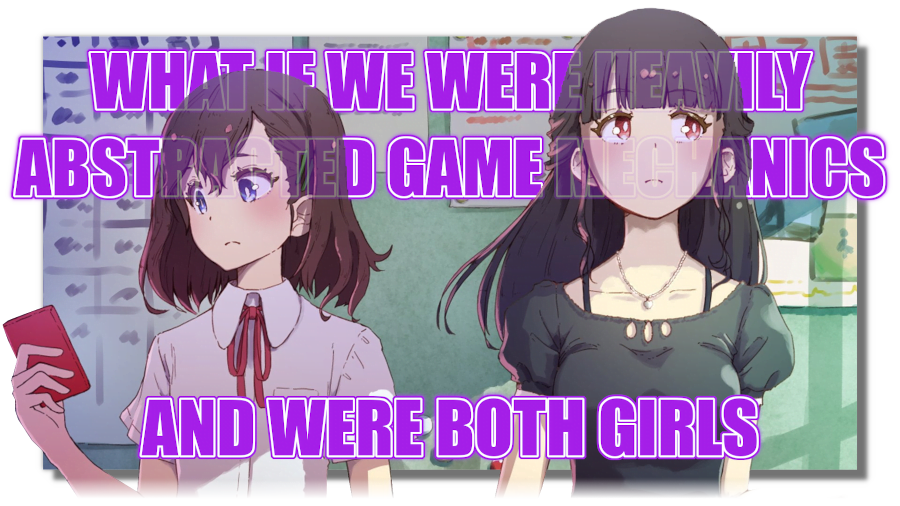Every month of 2022, I am trying, as part of both my PhD project and my all-purpose general game development, develop if not a whole game for game development, a project start, such that I can make playtest prototypes. This is a sort of report of the process throughout the month.
What game did I try to make this month?
Week 1 – Ending 5th
Here’s an idea – and it’s an idea I probably won’t use:
No You Hang Up is a card game about being the last one to hang up on a phone conversation. This is a thing from the 90s, when phone calls were a different kind of cultural deal, and often because the phone was in a common space. What happened is that shows would often depict a character on the phone with a romantic partner, and would then say they have to go, but wanting to wait until the other person hung up, a one-sided conversation would entail that went some variant of: “No, but you hang up. No, you hang up. You hang up.” and so on, implying that the other party was doing the same thing. This was usually done while laughing, often in changing pitches, because the people involved were so into each other they made even the task of hanging up a game, and also the people around them got annoyed by it.
This is a smoochy, romantic game idea, and also it’s extremely silly. I’m seeing something like The Mind coupled with Uno – you have a bunch of cards all saying the same thing, No, You Hang Up, with different suits and values on them. You want to play out your card to start the trick, your partner wants to play out the card they have that is as close as possible to it – up or down – and you’re trying to use up all the cards in your hand you can.
Math-wise, this game idea wants to be a list of numbered cards. The play experience wants to be a number that divides evenly between two players with a meaningful removal. So for example, it could be 30 cards, where you take out 6 cards, and set them aside, then each player shuffles up the remaining 24, and deal them out equally. This way players don’t have an equal play experience, they can’t map it out. You draw six cards and then you go through the play pattern in turn, until both players recognise that they can’t proceed, then players draw up to six again.
Maximum of three hands.
Your score is how many cards you can’t put into the middle, in each round. You’re aiming for a low score.
This would be a small game, making it a good print-and-play game. The biggest problem it has is that there’s no art asset worth putting in it, it’s basically just a 90s vibe and a phone icon in my mind. This is not a game that has a lot of substance to it; it’s one step removed from solitaire.
What I did come up with here was after a full day of thinking about it the idea of the Visual Novel Cute Girl Worker Placement idea, with tiles. The system here I like is the modal shift where the tile you pick up gives you a result, but then maybe influences the choices you have for your next result.
This game idea is a cool one but it does rely on assets I don’t think I have.
Week 2 – Ending 12th
Hey, I had an idea now – what about Ra?
Ra is a 1999 auction game. It has three mechanics that interest me:
- Players build the lot to auction or they call for an auction, creating a push-your-luck mechanism where you have tou determine how much other players are going to want the pile you’re making
- The bidding is in single round; you have to decide what you value each lot at the moment you bid on it, and you don’t get to revise that bid.
- When you bid, the winning bid becomes part of the next lot, meaning that early advantages even out over time.
The rest of the game design is in the things that become part of the auction. Thanks to the bidding mechanism, it’s hard for a player to stay behind the whole game, and the game happening over multiple rounds makes it about good decisions in aggregate.
In Ra, there’s:
- a tile that you can pull that triggers an auction
- a tile worth points on its own
- a tile that persists through rounds but only scores if you get a flood tile for that round
- gods that you can swap for tiles in lots before they’re bought
- sets where you score for each different one
- sets where you score for each matching one
I’d also add to the idea space here:
- tiles that score if you get the most
- tiles that score if you get the least
- tiles that score differently based on a starting piece of information
What’s the idea here, though?
I want to make a bidding game where you’re all fighting over the story beats of a visual novel. Possibly it’s over different protagonists, different boys you want to date, and your starting card is the girl, representing things she knows and doesn’t.
Next up, let’s look at the game fiction: If we’re building harems of characters and the winner has a reward based on how well the pieces they collected work together, we need to think about what the tiles represent.
Okay, making a decision: You are going to be collecting tiles to create the cast of a harem anime. That means you’re collecting characters, tropes that relate to those characters, locations, scenery, and maybe even to get cynical merchandisable elements.
Next step: I’m going to do a translation of Ra, just a 1:1 ‘do these tiles make sense with their new fiction,’ and then we’ll see what needs to change in the rules.
Week 3 – Ending 19th
Monday, I had a meeting where I explained the idea of this game to my supervisor. What I intend to do today (and may have to do tomorrow instead) is a point-by-point breakdown of Ra’s tiles and rethemes, to look for ‘fiction holes.’
The breakdown of components inside Ra, then, roughly:
- Point-tracker points. These are ignorable, or replicable, they’re not special game pieces. If the game goes light, this could be done with a pen and paper. They do give the game turn memory, which means that your score is not a final thing you build up to, but can increase over time.
- A bag. It has a bag to pull the tiles out of. Not nothing, and it can be replaced (if the tiles become, say, cards, this could be replaced by shuffling a deck). Bags allow for smaller tiles – cards need to be a handleable size, they reduce the challenge of restocking the deck. I like tiles and will try to use them.
- A quick check on Gamecrafter is that a game with 180 medium-sized token tiles is still going to have the bulk of its content comfortably under $20 in material costs. Obviously there’s more, book and box and whatnot, but this is a game that if it winds up sitting at $40-50 for a produced copy, I think that’s reasonable.
- There are five tiers of tiles you can get:
- Gods
- Pharaohs
- Niles and Floods
- Civilisations and Gold
- Monuments
- These five tiers let the design have also disasters, things that if you win them in an auction don’t just give you (say) negative points, but specifically ding your collection of one of its cards. This means you may view a disaster that hits you where you’re strong or very weak as equally not a problem, and that means each player will value tiles differently.
- Nonetheless, the five types score differently:
- Gold and gods are flat bonus points
- Pharaohs are tiered; whoever gets the most gets a fixed point value, with a tiebreaker system
- Nile tiles are only rewarded if they flood – A lot of nile is worth nothing, unless it floods. Nile persist from epoch to epoch
- Civilisation tiles penalise you if you have none and reward you for collecting four or five of the different types
- Monuments are scored in the end of the game, where they can give big payouts for both large and varied collections.
- The fiction is fine for a kind of civilisation builder. What about it has to change for a character-themed builder?
- monuments could be characters?Where each one has a set, and represents time spent with a character archetype in the narrative. Each tile could have a different version of the character on it, suggesting that the player gets to choose what ‘their kind’ of that character is like
- I want some A+B+C sets, like being able to stick a character to a ‘TSUN’ and ‘DERE” or ‘KYUU’ and ‘DERE” tile
- What does discarding a tile mean in this space?
Week 4 – Ending 26th
We have the base engine for the game, the bidding section from Ra.
I don’t want to include a score-keeping system like Ra has. The turn-to-turn scoring in Ra means that every round you’re tallying up numbers. I like that because it creates a sensation of time, and it creates a division between each round; you get to take all the tiles and put them back in the box.
What I want, instead, is to create the feeling of following a narrative through a structure. In this case, we’re going to make a season of an anime, which comes in three acts; intro, development, and conclusion.
You’re trying to acquire three different things:
- Plot tiles, which represent the genre or genres you’re building. More tiles represents more effort to include these themes in the narrative.
- Character tiles, which represent the development of a character throughout the story of the anime
- Sakuga tiles, where the budget hits and your anime gets to do something cool.
Sakuga tiles are just a flat bonus (though stuff interacts with them). Plot tiles are interchangeable, but they change the way scoring can work for you. If you have a one of many different types of plot, it incentivises a narrow cast, and if you have many of only one or two types of plot, that incentivises a broad cast. Also, possible, plot types reward different kinds of narrative. Characters are the majority of the tiles, and each act, you want to collect a number of them. Whenever you win an auction for tiles, you put them in your timeline, showing development over time.
There are seven types of girls you can have in your show:
- Genki girl
- Sukeban girl
- Dojikko girl
- Chuuni girl
- Senpai girl
- Bokuko girl
- Tsundere girl
And yes, these are all going to be girls for this version – mostly because the archetypes girls tend to get are more interesting, and because a lot of the guy archetypes in this space are kinda… worrying at times. Anyway, of the girls, each has a special scoring rule, except the Genki girl. The genki girl is 100% reliable everywhere. She will score you points no matter what, but she will also never interact weird with anything.
- The Sukeban girl, every turn you develop her, picks a rival in your roster. If that riavl didn’t develop this turn, she’s still considered to develop.
- The Dojikko girl, every turn you develop her, makes you discard a tile you got this round.
- The Chuuni girl improves the return of sakuga you got on the same turn as her
- The Senpai girl can’t develop unless she’s got the most tiles out of anyone in this turn
- The Bokuko girl gives you bonuses if her three rounds of development match
- The Tsundere girl gives you bonuses if each round she develops more than last round
In the bag of tiles, there are some tiles that represent problems, things that can happen to the development of a character, and hold them up. They are:
- Fights, which make you discard a Tsundere or Bokuko tile, because actually getting into fights is dangerous despite their style.
- Outbursts, which make you discard a Senpai or a Chuuni tile, because losing your cool is not how these characters work.
- Dokis, which make you discard a Sukeban or Dojikko, because they are people who cannot handle intense loving emotions cleanly.
However, of these three tiles, they can be ‘stowed’ and put into the development of other characters.
- Sukeban can add a Fight tile to their track
- Tsundere can add a Outburst tile to their track
- Senpais can add a Doki tile to their track
There’s also a Setback tile which asks you to discard a Most Developed track you have.
Some of the other tiles are just renames: God tiles are now Mysteries, where something that the storytellers seed early can be paid out later. But Mysteries might not be worth points at the end of the game. Ra tiles are now Drama tiles, where they force an abrupt change in the series’ status quo. Earthquakes are now Retcons, because the Monuments are now Plot Development.
Summary
At the stage I’m at, right now, I’m very seriously considering spending the next few days just churning out basic, icon-level versions of these tiles for a print-and-play version of this game that I can then playtest in class. I do think it’s going to have playtesting problems: There might not be enough variety in the tiles, it might not be good enough to fight over the tracks that you see yourself and others developing.
I like this game, I like the design I wound up with, and I liked how having a deadline helped me push to get hard parts of the design finished on time.
I am writing this half an hour before it publishes.





1 Trackback